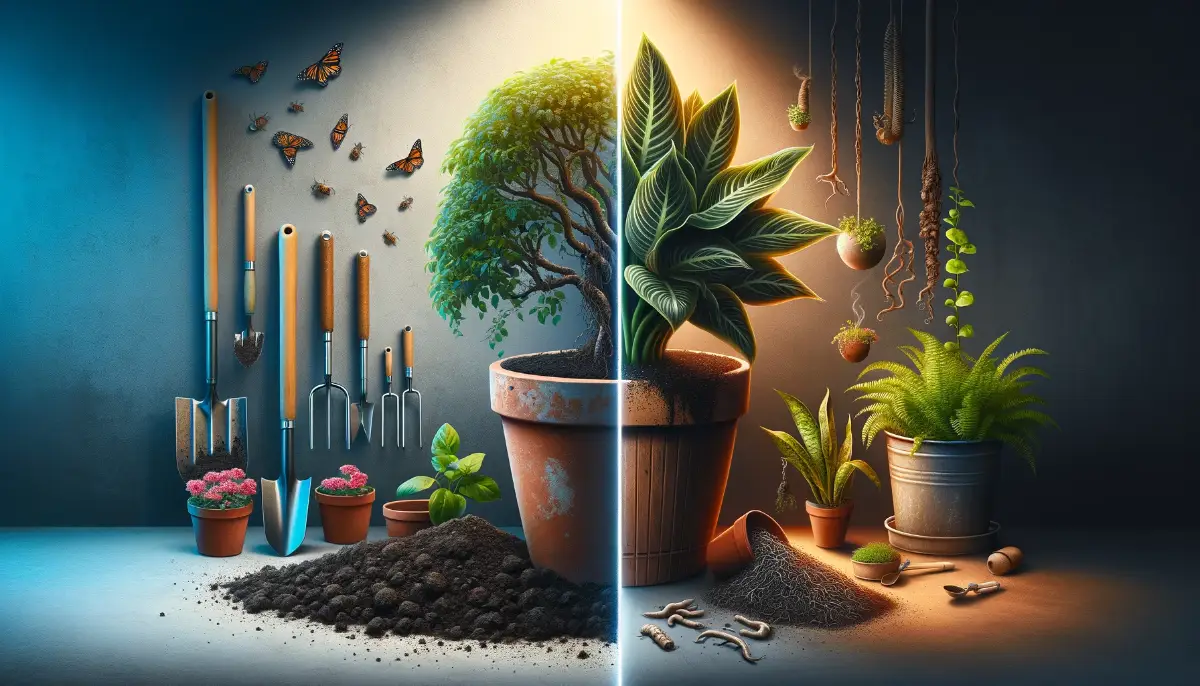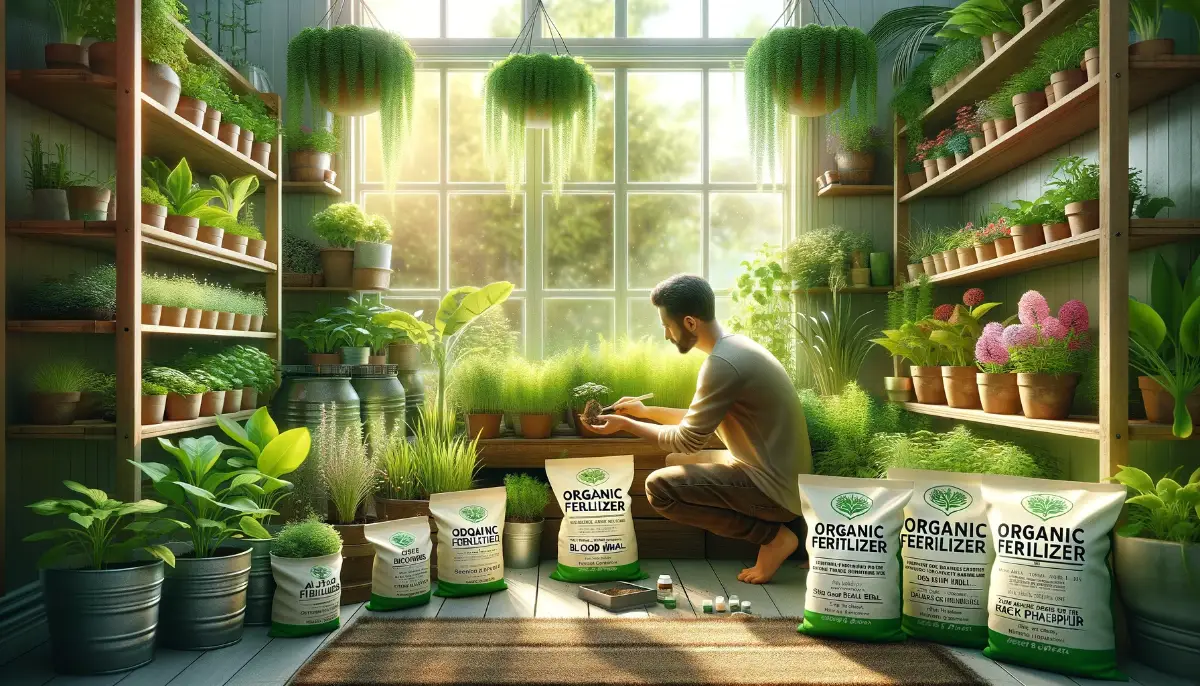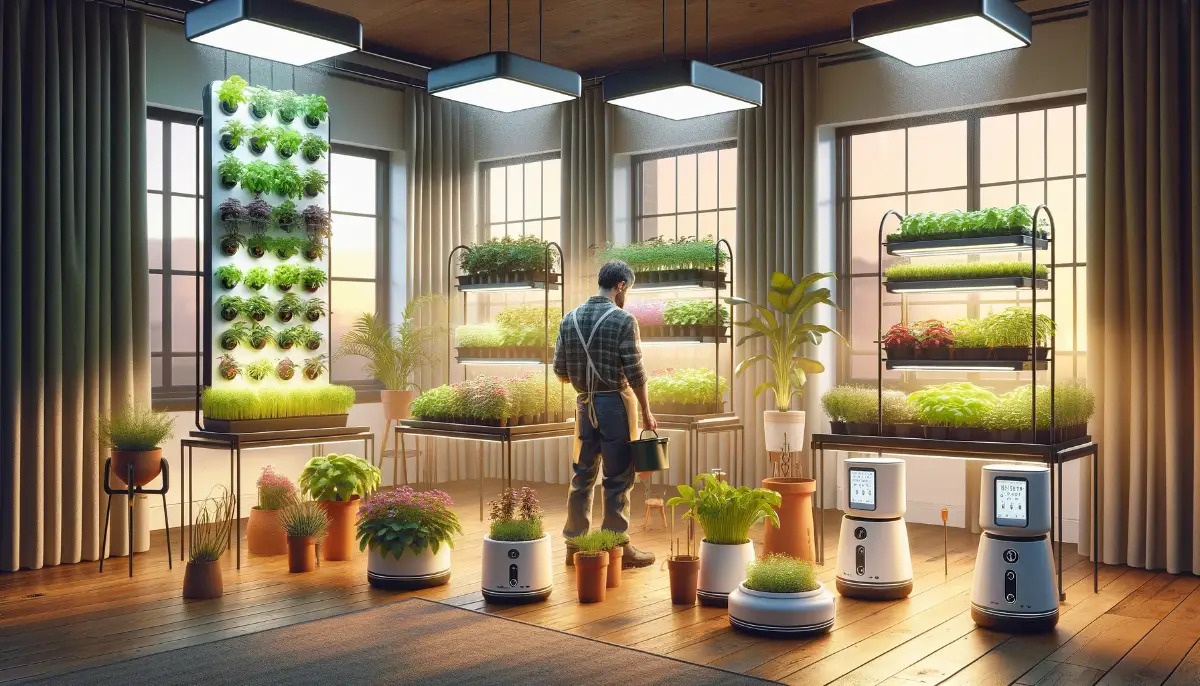Can I use normal soil for indoor plants? This question often puzzles many indoor gardening enthusiasts, leading to a debate between the convenience of scooping soil from the garden and the specialized nature of store-bought potting mixes.
While the idea of using garden soil for indoor plants might seem like a straightforward and cost-effective solution, it’s essential to delve into the nuances of soil types and their impacts on indoor plant health.
- Normal garden soil and potting mix serve different purposes; understanding their differences is crucial for indoor plant health.
- Garden soil needs to be modified for indoor use to ensure proper drainage and aeration.
- Sterilizing normal soil before indoor use can help mitigate the risk of pests and diseases.
Understanding Soil Types
Soil, the backbone of gardening, comes in various types, each with unique characteristics affecting water retention, nutrient availability, and drainage. The primary soil types include loamy, sandy, clay, and silt, each offering distinct advantages and challenges for plant growth.
- Loamy Soil: Often considered the ideal garden soil, loamy soil boasts a balanced mix of sand, silt, and clay, promoting excellent drainage, nutrient retention, and aeration.
- Sandy Soil: Characterized by large particles, sandy soil offers superior drainage but struggles to hold moisture and nutrients, posing a challenge for water-loving plants.
- Clay Soil: With its fine particles, clay soil excels in nutrient retention but often suffers from poor drainage, leading to waterlogged conditions detrimental to many plants.
- Silt Soil: Silt, with particles finer than sand but coarser than clay, strikes a balance in water retention and drainage but can compact easily, affecting root growth.
Normal garden soil typically comprises a mix of these types, with its composition varying based on location and previous cultivation practices. Its diversity can be both a blessing and a curse for indoor gardeners, necessitating a deeper understanding of its impact on indoor plants.
The Debate: Normal Soil vs. Potting Mix
When considering soil for indoor plants, the comparison between normal garden soil and potting mix becomes inevitable. Potting mix, designed specifically for container gardening, addresses the unique challenges of growing plants indoors, including the need for consistent moisture levels, adequate drainage, and disease prevention.
- Physical Differences: Potting mixes are usually lighter and more porous than garden soil, promoting better aeration and drainage within the confines of a pot. This structure helps prevent waterlogging, a common issue with denser garden soils when used indoors.
- Biological Differences: Garden soil is teeming with life, both beneficial and harmful. While this biodiversity is vital in an outdoor setting, introducing garden soil indoors can also introduce pests and pathogens. In contrast, potting mixes are often sterilized or treated to minimize these risks, providing a safer environment for indoor plants.
The debate hinges on balancing the benefits of each medium against its drawbacks. While garden soil offers familiarity and ease of access, the tailored composition of potting mixes aligns closely with the specific needs of indoor plants, making them a popular choice among indoor gardening enthusiasts.
This segment sets the foundation for understanding the complexities of using normal soil for indoor plants, emphasizing the importance of soil type knowledge and the considerations needed when opting for garden soil over specialized potting mixes.
The next part of the article will delve further into the advantages and drawbacks of using normal soil indoors, along with guidelines for its safe and effective use.
Advantages of Using Normal Soil for Indoor Plants
Using normal soil from your garden for indoor plants offers several benefits, primarily revolving around accessibility and cost-effectiveness. For many gardeners, the idea of utilizing what they already have on hand is appealing, reducing the need for additional purchases.
- Accessibility: Garden soil is readily available for most homeowners, eliminating the need to buy specialized potting mixes.
- Cost-Effectiveness: By using soil from your garden, you can save money, especially if you have a large number of plants or frequent repotting needs.
- Customization: With a basic understanding of your plants’ needs and soil amendments, you can tailor the garden soil to suit specific requirements, potentially creating a more suitable growth medium than off-the-shelf potting mixes.
Drawbacks of Using Normal Soil Indoors
While the benefits of using garden soil are clear, several significant drawbacks must be considered to ensure the health and vitality of indoor plants.
- Drainage and Aeration Issues: Garden soil, especially if heavy in clay, can compact in pots, restricting airflow to the roots and preventing proper drainage. This can lead to waterlogged conditions, root rot, and ultimately, plant death.
- Pests and Diseases: Normal soil is often home to a variety of pests and diseases that can be harmful to indoor plants. Introducing garden soil to an indoor environment can inadvertently spread these issues, leading to infestations or sickness in previously healthy plants.
- Nutrient Imbalance: The nutrient composition of garden soil may not be ideal for all indoor plants. Some might require more specific nutrient ratios or pH levels than what normal soil can offer.
How to Use Normal Soil for Indoor Plants Safely
Despite the challenges, it is possible to use garden soil for indoor plants if you take steps to mitigate the risks mentioned above.
- Sterilize the Soil: To eliminate pests, diseases, and weed seeds, sterilize the garden soil before use. This can be done by baking it in the oven at 200°F (about 93°C) for 30 minutes or using a microwave.
- Improve Drainage and Aeration: Mix garden soil with amendments like perlite, vermiculite, or sand to enhance its drainage and aeration properties. This adjustment is crucial for mimicking the light, porous nature of potting mixes.
- Enrich the Soil: Incorporate compost or well-rotted manure to boost the nutrient content of your garden soil. This organic matter not only enriches the soil but also improves its overall structure and water-holding capacity.
Tips for Modifying Normal Soil for Indoor Use
To successfully use garden soil in indoor pots, consider the following tips:
- Conduct a Soil Test: Understanding your garden soil’s current nutrient and pH levels can guide how you amend it for indoor use.
- Choose the Right Amendments: Select amendments based on your soil’s existing condition and the specific needs of your plants. For instance, add more perlite for drainage or compost for nutrients.
- Monitor Plant Health: After potting your plants with modified garden soil, keep a close eye on their health. Signs of distress can indicate issues with the soil composition or the need for further adjustments.
FAQs on Normal Soil for Indoor Plants
Can I use garden soil for all types of indoor plants?
Not all indoor plants thrive in garden soil due to its dense structure and potential for pests and pathogens. While it’s possible to use modified garden soil for indoor plants, some, especially those requiring high drainage or specific soil pH, might perform better in a specialized potting mix. It’s essential to consider the specific needs of each plant species.
How often should I replace normal soil in indoor plant pots?
The frequency of soil replacement depends on several factors, including the plant’s growth rate, soil condition, and any signs of nutrient depletion or contamination. Generally, replacing or refreshing the soil in indoor pots every 1-2 years can help maintain plant health and vigor.
However, closely monitor your plants for signs that they might need a soil change sooner, such as slowed growth, yellowing leaves, or drainage issues.
Is it necessary to sterilize normal soil before using it indoors?
Yes, sterilizing garden soil before using it for indoor plants is highly recommended to kill off any pests, diseases, and weed seeds present in the soil. Sterilization can be done by baking the soil in an oven at 200°F (93°C) for at least 30 minutes or using a microwave.
This process helps to ensure that the soil is safe for indoor use and reduces the risk of introducing unwanted problems to your indoor garden.
Can I mix garden soil with potting mix for indoor plants?
Mixing garden soil with potting mix can be a viable way to utilize the benefits of both mediums. This combination can help improve the drainage and aeration of garden soil while adding the structural stability of potting mix.
Ensure that the garden soil is sterilized before mixing to prevent the spread of pests and diseases. The ratio of garden soil to potting mix should be carefully considered based on the specific requirements of each plant.
How can I improve the drainage of normal soil for indoor use?
Improving the drainage of garden soil for indoor use involves incorporating amendments that increase its porosity and allow water to flow through more freely. Materials such as perlite, vermiculite, coarse sand, or even small pebbles can be mixed with garden soil to enhance drainage.
Additionally, ensuring that your pots have adequate drainage holes is crucial to prevent waterlogging.
What are the signs that my indoor plant is not thriving in garden soil?
Signs that your indoor plant may not be thriving in garden soil include stunted growth, yellowing or dropping leaves, signs of root rot (such as a mushy base or foul smell from the soil), and persistent pest or disease issues. If you notice any of these symptoms, consider repotting the plant with a fresh, possibly different soil mix, after addressing any specific issues.









